Erich Honecker
| Erich Honecker | |
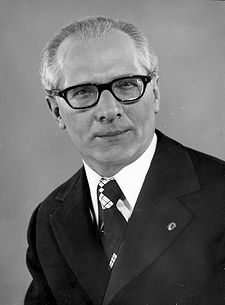 |
|
|
General Secretary of the Central Committee of the Socialist Unity Party of Germany
|
|
|---|---|
| In office 1971–1989 |
|
| Preceded by | Walter Ulbricht |
| Succeeded by | Egon Krenz |
|
Chairman of the Council of State of the German Democratic Republic
|
|
| In office 29 October 1976 – 18 October 1989 |
|
| Preceded by | Willi Stoph |
| Succeeded by | Egon Krenz |
|
Chairman of the National Defense Council of the German Democratic Republic
|
|
| In office 1971–1989 |
|
| Preceded by | Walter Ulbricht |
| Succeeded by | Egon Krenz |
|
|
|
| Born | August 25, 1912 Neunkirchen, German Empire |
| Died | May 29, 1994 (aged 81) Santiago, Chile |
| Nationality | German |
| Political party | Socialist Unity Party of Germany |
| Spouse(s) | Edith Baumann (1950-1953) Margot Feist Honecker (b. 1927) |
| Profession | Politician |
| Religion | Atheism |
Erich Honecker (German pronunciation: [ˈeːʁɪç ˈhɔnɛkɐ]; 25 August 1912 – 29 May 1994) was a German Communist politician who led the German Democratic Republic (East Germany) from 1971 until 1989.
Following the annexation of the German Democratic Republic, Honecker first fled to the Soviet Union but was extradited to Germany by the new Russian government. Back in Germany, he was imprisoned and tried for high treason and crimes committed during the Cold War. In particular, he was indicted for ordering border guards to shoot any person trying to cross the East German border into West Germany or West Berlin. However, during the trial, Honecker became ill with terminal cancer and was subsequently released from prison. He died in exile in Chile about a year and a half later.
Contents |
Origins and early political career
Honecker was born on Max-Braun-Straße in Neunkirchen, now Saarland, as the son of Wilhelm Honecker, a coal miner and political activitist,[1] who in 1905 had married Caroline Catharina Weidenhof. There were six children born to the family: Katharina (Käthe), Wilhelm (Willi), Frieda, Erich, Gertrud (b. 1917; m. Hoppstädter), and Karl-Robert.
After World War I, the Saar region was handed over to France. This change from the strict rule of Baron von Stumm to French military occupation provided the backdrop for what Wilhelm Honecker understood as proletarian exploitation, and introduced young Erich to communism.[1] In 1922 at 10 years old, he joined the Spartacus League, then the Young Communist League of Germany (KJVD), the youth section of the Communist Party of Germany (KPD), in 1926.[1] and joined the KPD itself in 1929. Between 1928 and 1930 he worked as a roofer, but did not finish his apprenticeship. Thereafter he was sent to Moscow to study at the International Lenin School and for the rest of his life remained a full-time politician.
He returned to Germany in 1931 and was arrested in 1935, two years after the Nazis had come to power. In 1937, he was sentenced to ten years for Communist activities and remained a prisoner until the end of World War II. At the end of the war, Honecker resumed activity in the party under leader Walter Ulbricht, and, in 1946, became one of the first members of the Socialist Unity Party of Germany (Sozialistische Einheitspartei Deutschlands, SED), which was formed by the merger of the KPD and the Social Democratic Party (SPD) in the Soviet occupation zone of Germany.
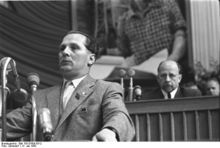
Following the SED victory in the October 1946 elections, Honecker took his place amongst the SED leadership in the first postwar East German parliament, the German People's Congress (Deutscher Volkskongress). The German Democratic Republic was proclaimed on 7 October 1949 with the adoption of a new constitution, establishing a political system similar to that of the Soviet Union. Honecker was a candidate member for the secretariat of the Central Committee in 1950; by 1958, he had become a full member of the Politbüro.
Leadership of East Germany
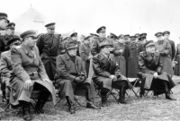
In 1961, Honecker, as the Central Committee secretary for security matters, was in charge of the building of the Berlin Wall. In 1971, he initiated a political power struggle that led, with Soviet support, to his becoming the new leader, replacing Walter Ulbricht as First Secretary of the SED Central Committee and as chairman of the National Defense Council. In 1976, he also became Chairman of the Council of State (Vorsitzender des Staatsrats der DDR) and thus the de facto head of state.
Under Honecker's leadership, the GDR adopted a program of "consumer socialism," which resulted in a marked improvement in living standards already the highest among the Eastern bloc countries. More attention was placed on the availability of consumer goods, and the construction of new housing was accelerated, with Honecker promising to "settle the housing problem as an issue of social relevance."[2] Yet, despite improved living conditions, internal dissent was not tolerated. Around 125 East German citizens [3] were killed during this period while trying to illegally cross the border into West Germany or West Berlin.
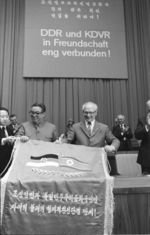
In foreign relations, Honecker renounced the objective of a unified Germany and adopted the "defensive" position of ideological Abgrenzung (demarcation). He combined loyalty to the USSR with flexibility toward détente, especially in relation to rapprochement with West Germany. In September 1987, he became the first East German head of state to visit West Germany.
In the late 1980s Soviet leader Mikhail Gorbachev introduced glasnost and perestroika, reforms to liberalise communism. Honecker and the East German government refused to implement similar reforms in the GDR, with Honecker reportedly telling Gorbachev: "We have done our perestroika, we have nothing to restructure." [4] As the reform movement spread throughout Central and Eastern Europe, mass demonstrations against the East German government erupted, most prominently the 1989 East German Monday demonstrations in Leipzig. Faced with civil unrest, Honecker's Politbüro comrades colluded to replace him. The elderly and ill Honecker was forced to resign on 18 October 1989, and was replaced by Egon Krenz.
Post-1989
After the GDR was dissolved in October 1990, the Honeckers stayed with the family of the Lutheran pastor Uwe Holmer. Honecker then stayed in a Soviet military hospital near Berlin before later fleeing with Margot Honecker to Moscow, to avoid prosecution over charges of Cold War crimes. He was accused by the German government of involvement in the deaths of 192 East Germans who tried to illegally leave the GDR. Following the dissolution of the Soviet Union in December 1991, Honecker took refuge in the Chilean embassy in Moscow, but was extradited by the Yeltsin administration to Germany in 1992. When the trial formally opened in early 1993, Honecker was released due to ill health and on 13 January of that year moved to Chile to live with his daughter Sonja, her Chilean husband Leo Yáñez, and their son Roberto. He died of liver cancer in Santiago.
Personal
Honecker married Edith Baumann in 1950 and divorced her in 1953. They had a daughter, Erika (b. 1950). In 1953 he married Margot Feist and they remained married until his death. They had a daughter, Sonja, born in 1952. Margot Honecker served for more than 20 years as the GDR Minister for People's Education.
It is claimed that Honecker was addicted to game hunting and was directly involved in the over-hunting a number of native game species. Such was his passion that animals bred and reared in neighbouring communist countries had to be supplied for his regular hunting parties.[5]
Famous quotes
- "The Wall will be standing in 50 and even in 100 years, if the reasons for it are not yet removed." (Berlin, 19 January 1989) (Original: "Die Mauer wird in 50 und auch in 100 Jahren noch bestehen bleiben, wenn die dazu vorhandenen Gründe noch nicht beseitigt sind")
- "Neither an ox nor a donkey is able to stop the progress of socialism." (A rhyming couplet in the original German: "Den Sozialismus in seinem Lauf hält weder Ochs noch Esel auf", Berlin, 7 October 1989), one of Honecker's favorite adages, originally coined by August Bebel. (The ox and the donkey are symbolic of stubborn stupidity in German culture.)
- "The future belongs to socialism" (Original: Die Zukunft gehört dem Sozialismus) (early 1980s)
- "Always forwards, never backwards." (Original: Vorwärts immer, rückwärts nimmer) (early 1980s)
In popular culture
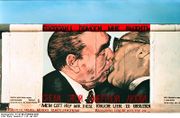
- Honecker was famously depicted passionately kissing Soviet leader Leonid Brezhnev in a satirical mural entitled "Brotherhood Kiss" on the Berlin Wall (East Side Gallery), painted by artist Dmitri Vrubel.
References
- ↑ 1.0 1.1 1.2 Wilsford (1995) p.195
- ↑ Honecker, Erich. 1984. The GDR: A State of Peace and Socialism http://www.calvin.edu/academic/cas/gpa/erich1.htm
- ↑ List of Berlin Wall victims http://www.chronik-der-mauer.de/index.php/de/Start/Index/id/593792
- ↑ [1]
- ↑ "The Lost World of Communism", Episode 2 - A Socialist Paradise: East Germany, BBC 1, broadcast 14 March 2009
Bibliography
- Wilsford, David. (1995) Political leaders of contemporary Western Europe: a biographical dictionary. Greenwood Publishing Group.
Further reading
- Fulbrook, Mary. (2008) The people's state: East German society from Hitler to Honecker. Yale University Press.
- Honecker, Erich. (1981) Aus meinem Leben. New York : Pergamon, 1981. ISBN 0080245323.
External links
- Erich Honecker - The Independent Obituary
- CNN Cold War - Profile: Erich Honecker
- Honecker im Internet (in German)
- www.warheroes.ru - Erich Honecker (in Russian)
- Welcoming Address to 1979 Session of the World Peace Council Erich Honecker's speech to the WPC
- A Successful Policy Seared to the Needs of the People Volkskammer pamphlet including material by Honecker
| Political offices | ||
|---|---|---|
| Preceded by Walter Ulbricht |
General Secretary of the Central Committee of the Socialist Unity Party of Germany 1971 – 1989 |
Succeeded by Egon Krenz |
| Preceded by Willi Stoph |
Chairman of the Council of State of the German Democratic Republic 1976 – 1989 |
|
|
|||||
|
|||||||||||||
|
||||||||||||||||||||||||||||||||||||||||||||
|
|||||||||||||||||||||||||||||||||||||||||||||||||||||